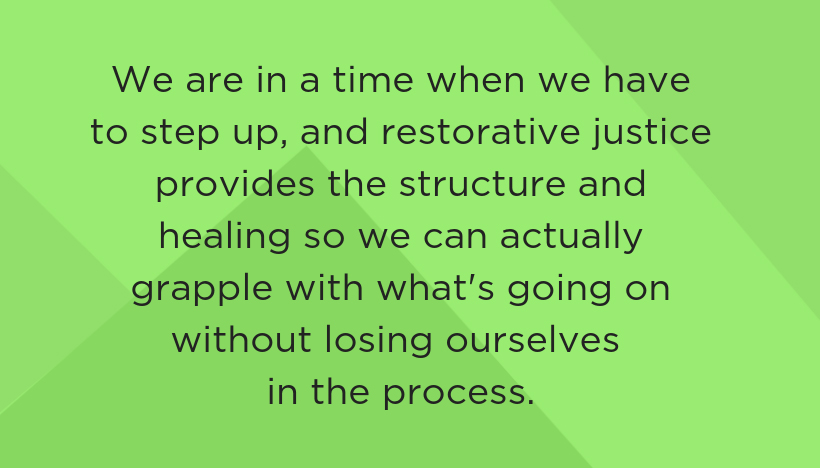An excerpt from this text appears in the September 2019 issue of The Council Chronicle.
In Restorative Justice in the English Language Arts Classroom (NCTE, 2019), the authors show how English teachers can think and plan using a restorative justice lens to address issues of student disconnection and alienation; adult and youth well-being in schools; and inequity and racial justice through writing, reading, speaking, and action.
In this post the authors of Restorative Justice—Maisha T. Winn, Hannah Graham, and Rita Renjitham Alfred—share some hows and whys about coming together to produce their book.
How did this book come to be?
Maisha: In 2015 I spent time learning about restorative justice (RJ) from a team of attorneys at Impact Justice who insisted I take Rita Alfred’s restorative justice training. Rita’s training was powerful and she and I discussed how we were trying to bridge the work we do with teachers with the work we do with restorative justice practitioners. We found ourselves collecting materials prior to our trainings for teachers and trying to assemble them in a cohesive and coherent way. We started dreaming and imagining a book like Restorative Justice in the English Language Arts Classroom.
Hannah and I worked closely at UW Madison where she was my advisee in the graduate program; she had a lot of experience as a curriculum developer and I asked her to join the English Education team as a supervisor.
Rita: My friends at Impact Justice were very excited to have met Maisha and have heard me say how much I was wanting to collaborate with the professors teaching in the teacher’s credential programs. I wanted to work with the educators of teachers to understand how to provide what teachers needed to be able to practice restorative justice in classrooms. And I wanted help to notice and see how restorative justice philosophy, principles, and practices were already somewhat related to their disciplines.
I have been in trainings where I have met amazing educators who demonstrated how they would use restorative justice in the classrooms to relate what they taught even with mathematics and science. I believe that people who enter teaching are doing so because of their love for their discipline and hopefully also a great love for children.
However, the way our education system is in this country, there has not been space or time for teachers to reflect on their practices when it comes to what and how they are affirming their relationships with the young people they teach, because of the stress of meeting the standards and class sizes that stressed teachers out, such that it was hard for them to prioritize the needs of both teachers and young people in classrooms.
So when I meet Maisha and then was introduced to Hannah, I got very excited because my hope was answered. Our writing this book together has really confirmed that we can continue to do this work for all the disciplines and invite teachers to use restorative justice with as much support as possible. Teachers are precious people and I want to add to their joy and health in the classroom and life.
You come from different backgrounds. How do your differences strengthen your positionality in this work?
Maisha: The common thread throughout all of our work is that we are about doing the right thing when it comes to children. All of us are very strong in our racial/cultural/ethnic identities and this—I believe—makes it easier for us to respect and honor others’ way of knowing and building.
Rita: I appreciate Maisha’s brilliance with the discussions of the realities of racism, her understanding of youth voices, and her creativity of including the young people as the people most affected and most familiar with what is needed in the classroom. I appreciated and learned so much from Hannah about what it means to be a skillful writer. I was so elated to be writing with her and appreciated her expertise about how to express and organize the many ideas we had for this book. I definitely felt the love we all felt for young people and for the special people who were called to the profession of teaching.
The marriage of personal and professional experiences and skills within this collaboration was very helpful for me when I remember that we have found ourselves in a new normal in this racist and dangerous time in our country and I was grateful for the honesty and openness, from my co-writers, to not shy away from the hard facts of the truth we were seeing around us. And we were able to spend time expressing our grief about the black lives lost and the power issues that we were experiencing constantly.
Why restorative justice? Why now?
Maisha: Rita always says “restorative justice is old.” Indigenous communities throughout the world engage in relationship building. We can learn from them. We must learn from them.
Rita: We talked in 2015; there was a presidential election in 2016; black lives were being targeted and murdered blatantly; our youth were either getting killed, lost in systems—from child welfare to detention. We needed schools to be a safe space for our young people and to be the greatest youth development organization, one that intervenes when we, as the adults in charge of this world, are not attending to how we are leaving it for the seven generations coming after us. I understand that this has been going on from the very beginning of our country’s history, however, in the recent past, the urgency has been rising to an emergency, and restorative justice allows for our peacemaker voices and actions to be heard and seen.
The justice—or more truthfully the “injustice”—system that we have in place continues to destroy people of color. Our nation is in a time when we are peeling off band-aids we have put on racism. I am grateful for the truth. And now the work is hard and real. There is evidence that restorative justice works in schools, in the justice/injustice system, and in the communities, so why are we not using it more? And why are we continuing to use the methods and thinking that produced the disaster we are experiencing now?
There are proven and noted data that the systems we are using now are not working to stem loss of our youth, or the increasing the number of people of color in detention when crime numbers are falling. We are in a time when we have to step up, and restorative justice provides the structure and healing so we can actually grapple with what’s going on without losing ourselves in the process.
Can you talk a little about the power of linking restorative justice to content specific goals/objectives?
Maisha: Being in community and valuing relationships does not take the place of creating learning spaces for intellectual engagement. Both must be done together. We want educators to have powerful and dynamic relationships with students to expand opportunities to learn deeply.
Rita: Our schools touch the most number of youth who are the future and our future. If we want our future to look different from what we are experiencing now, we have to learn from our indigenous relatives of how to be wise elders and seek out ways to embed the restorative justice philosophy and practices into our schools.
If we do not push to consider how RJ is linked to content goals and objectives, it will end up becoming a “program,” versus a way of being to change this world we are experiencing now. School improvement programs come and go, however, if RJ is introduced as tied to content specific objectives, it will become embedded and difficult to see it “go,” like so many expensive programs that come and go in two years or less.
Hannah: Understanding restorative justice as an ethos of care and responsibility in the classroom means that content goals always hold an opportunity to restore and build. Every content area has opportunities to use the tools of their discipline to transform community. In our book we focus on English language arts, and how reading and writing can be used as tools to listen, co-create, understand, and question.
What do you want educators to take with them after reading Restorative Justice in the English Language Arts Classroom?
Maisha: We hope educators will seek out restorative justice community-building training AND think about how they can engage in an RJ mindset, to set up their classroom in such a way that everyone can cultivate a sense of purpose and belonging.
Rita: We hope that they will be intrigued and seek out restorative justice training and examine their beliefs and practices so that we all can have the lives we want where all people can be treated with dignity and respect. We hope readers will understand that RJ work isn’t a programmatic intervention or a single-strategy professional development training; it is much more. We hope they will realize that restorative justice work involves an embodiment of the philosophy and praxis by doing. Practicing restorative justice enables us to reframe our very profession, existence, how we relate to others, and to articulate and enact ways of being that center worthiness, accountability, well-being and justice in the ways we practice and produce a culture of relating.
It requires humility and self-reflectiveness around power, class, educational and racial privilege, and this book encourages readers to see how they can use this in their classroom. We hope that this book will encourage readers to do restorative justice work in the classroom in line with their ELA curriculum to fundamentally challenge our assumptions around professional practice, time, and the centrality of expertise, not relationship, so pervasive in our society. Finally we hope that they will be encouraged to practice restorative justice and realize that young people are gifts to us, to treat all of them as gifts, and to experience a richer work environment.
Hannah: We hope educators will consider how the everyday reading and writing practices they facilitate in their classrooms hold opportunities to call all students into community, and engage in the (career-long) process of auditing the extent to which their space, pedagogy, and approach is set up to do just that. In each chapter we walk through possible avenues for (re)assessing and altering classroom dialogue, atmosphere, and power dynamics (including a section on educators building their own syllabus for personal expansion). Moreover, we contend that our book is just the beginning; throughout our text we offer multiple suggestions for continued reading and action educators can take to explore the exclusionary history of schooling/literacy practices and means to redress these in English language arts community.

Rita Renjitham Alfred has dedicated many years to serving youth and families in the Bay Area. She started her career in restorative justice as the restorative justice coordinator at Cole Middle School in the Oakland [California] Unified School District (OUSD) and later with Restorative Justice for Oakland Youth. She interfaced with the various system stakeholders, including school site and district administration, teachers, students and families, school and city police, and community-based organizations, to lead a successful program. The pilot program at Cole was so effective in reducing suspensions, expulsions, and violence that staff at approximately 20 additional schools sought training and technical assistance to bring restorative practices to their sites. Due in large part to these efforts, in January 2010, Renjitham Alfred and others helped the OUSD School Board pass a resolution adopting restorative justice district-wide as official policy. Since that time, she has trained more than 4,000 people in schools, coaching and consulting with six other school districts to adopt restorative justice practices at their schools. As an independent contractor, she founded the Restorative Justice Training Institute, which holds RJ trainings and consults and coaches in schools. Renjitham Alfred collaborates with teachers to integrate RJE elements in daily academic classes. She has two sons and two grandchildren and lives in the Bay Area.

Maisha T. Winn is Chancellor’s Leadership Professor at the University of California, Davis, and codirector (with Torry Winn) of UC Davis’s Transformative Justice in Education (TJE) Center. Her program of research examines the ways in which teachers and/or adult allies for youth in schools and in out-of-school contexts practice “justice” in the teaching of literacy. Winn was named an American Educational Research Association Fellow in 2016, received the William T. Grant Foundation Distinguished Fellowship in 2014, and received the American Educational Research Association Early Career Award in 2012. She has authored several books, including Writing in Rhythm: Spoken Word Poetry in Urban Schools (2007, published under “Fisher”), Black Literate Lives: Historical and Contemporary Perspectives (2009, published under “Fisher”), Girl Time: Literacy, Justice, and the School-to-Prison Pipeline (2011), and most recently Justice on Both Sides: Transforming Education through Restorative Justice (2018), and is coeditor of Humanizing Research: Decolonizing Qualitative Inquiry with Youth and Communities (with Django Paris). Winn is also the author of numerous articles in peer-reviewed journals, including Review of Research in Education; Anthropology and Education Quarterly; International Journal of Qualitative Studies in Education; Race Ethnicity and Education; Research in the Teaching of English; Race and Social Problems; and Harvard Educational Review.

Hannah Graham is a curriculum consultant and professional development leader who works with schools and nonprofit organizations interested in enhancing classroom literacy instruction. A former secondary ELA teacher, Graham’s work focuses on advancing the power of educators and their students to transform classroom communities using reading and writing as central tools. She is currently director of professional learning for WebbAlign and a PhD candidate in the Department of Curriculum and Instruction at the University of Wisconsin-Madison.

